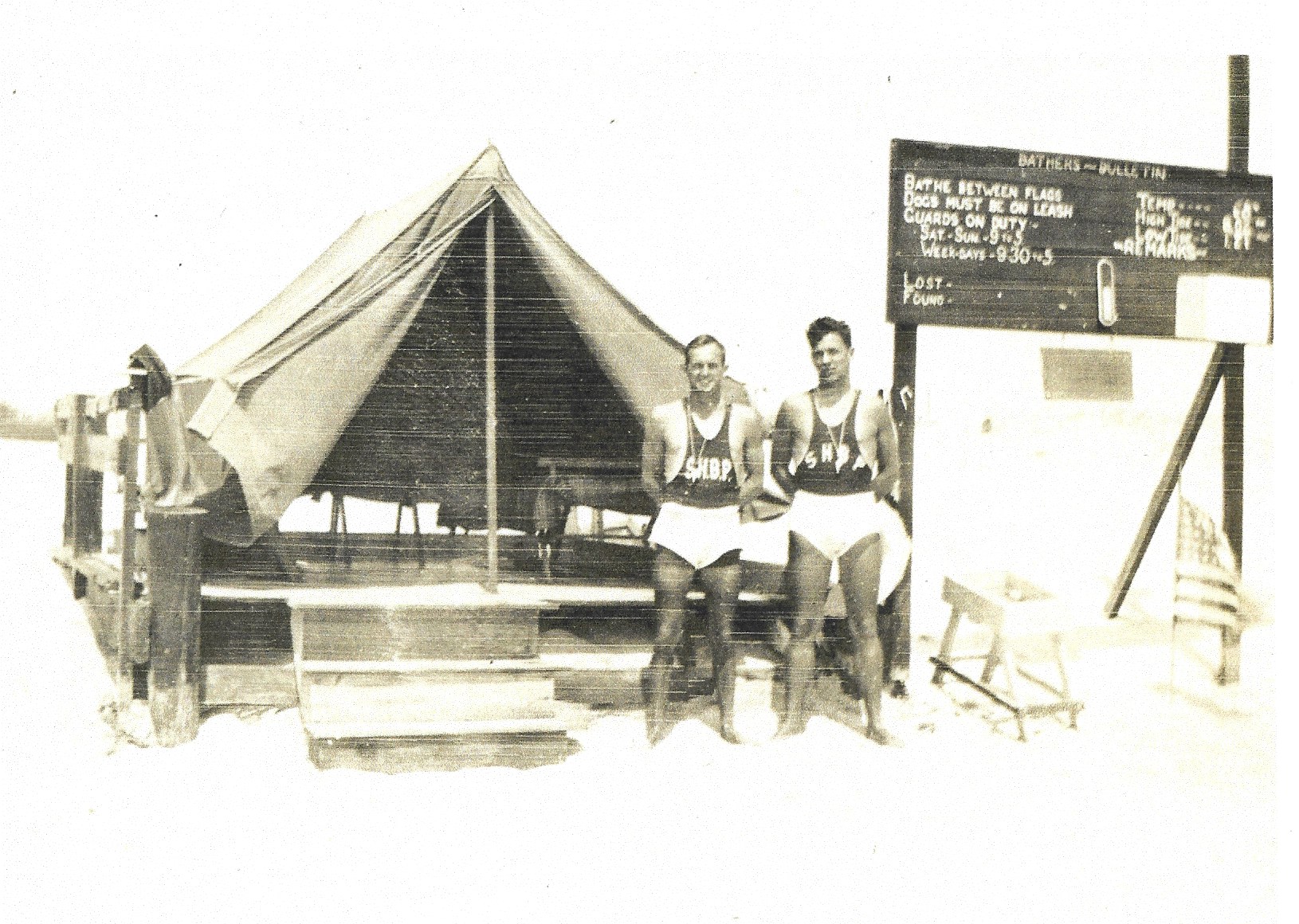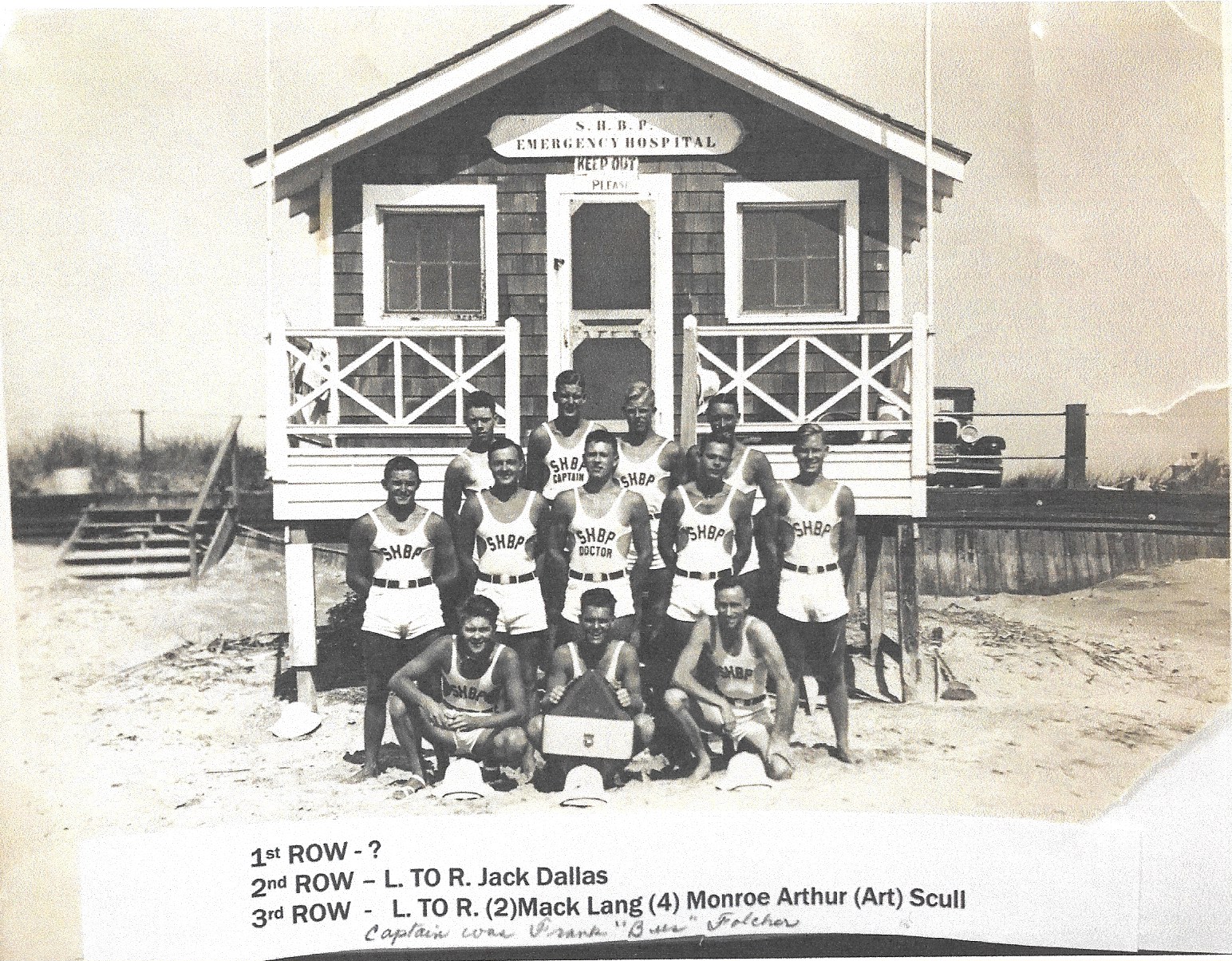
No. 35
Let’s check out what was going on at the 108th Street Stone Harbor Beach Patrol station back one day in the summer of 1930. Interestingly, the life guard station shown here manned by 2 young men consisted of a tent as well as a bulletin board for daily beach information labeled “Bathers Bulletin”. I magnified this Stone Harbor Museum archives image and was successful in deciphering all of the information written on the bulletin board for that given day. Here is the exact information I managed to make out that was actually inscribed on the chalk board and I thought many of you might find it of some interest. Here goes…
BATHERS BULLETIN
BATHE BETWEEN FLAGS
DOGS MUST BE ON LEASH
GUARDS ON DUTY
SAT. – SUN. – 9 TO 5
WEEK – DAYS – 9:30 – 5
LOST –
FOUND –
(A thermometer is situated on the bathers board as well to give the air temperature on the beach at the time)
(Water) TEMP. – 68
HIGH TIDE – 8:02 AM
LOW TIDE – 2:28 PM
REMARKS – (none)
Here are some other observations about this photograph that readers might find of interest. It appears the Stone Harbor Beach Patrol station has utilized an old army surplus 9” X 12” heavy canvas wall tent for shelter out of the sun. The tent is set up on a wooden platform common of that era. Two steps lead from the beach to the platform where we can see a chair, a table and a cot. The two tanned and muscular young life guards with their whistles on lanyards around their necks stand on duty in front of this emergency set up. To the right of this image you will see an American Flag fluttering in the land breeze.
For the record, providing water safety protection for the bathers who enjoyed swimming in the ocean at the Stone Harbor beaches would become a vitally important matter. In 1912 the Risley brothers provided a young 16-year old lad by the name of Cleon Krouse to be a “one-man” Beach Patrol who was stationed at 94th Street. Krouse for the next 2 years served as a volunteer life guard only receiving tips as any compensation for his life guarding services. In 1914 however, when Stone Harbor became a full-fledged governmental municipality and was officially incorporated as a borough, life guards then came directly under the jurisdiction of the town itself.

Even in 1920 there was just one life guard and his name was Hervey Gash who was the only “surfman” on the borough’s payroll. By 1922 and with increasing numbers of vacationers using the beaches, the Stone Harbor Beach Patrol was expanded to 4 life guards with a degree of formal organization and some minimal facilities. Before long First Aid services were being provided with a medical student at first and then later a doctor at a smallish “Emergency Hospital” located on the beach at 94th Street (see photo shown immediately above). Notice 12 young life guards including the Captain named Frank Folcher in the back row accompanied by a Doctor in the middle row. You can also see in the front row one of the life guards holding an important piece of life saving equipment ideally suited for ocean surf rescues called a diamond buoy. The life buoy was a flotation device that was carried out through the surf by the life guard and literally placed in front of an actual drowning/struggling victim during a rescue. The rescuer would then holding the rope which was wrapped across and around his upper body or torso with the victim now holding on to the floating buoy would commence swimming back to shore with the victim under control. This sort of rescue procedure was preferred or considered safest so as not to endanger the life of the individual doing the rescue and thus prevent yet the possibility of a double drowning should a panicky thrashing victim seek to endanger the life of the rescuer.
In addition, the 1920s saw the advent and use of sturdy wooden life boats designed for use in the rough surf along with life guards being required to train rigorously and satisfy American Red Cross standards for lifesaving and water safety. For example, it was especially important for life guards to know how to be able to provide means of resuscitation to unconscious or non-breathing victims of drowning incidents. Over time the life guard crews would be able to carry out a multitude of other vitally important life saving techniques and practices with the use of more life saving equipment such as diamond buoys and ring buoys just to mention a couple. Eventually there would be as many as 16 different beaches that would offer life guard protection.
Should you have further interest in learning more about the Stone Harbor Beach Patrol, please go to “Harlan’s History” accounts on the Stone Harbor Museum webpage. Locate article No. 48 and you will be presented with more background information along with 18 different photographic and post card images.
